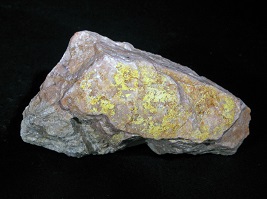
Locality: Parker Mtn. Mine, Strafford, NH
Specimen Size: 6 cm specimen. Feldspar with yellow phosphuranylite crust.
Field Collected: Gene Bears
Catalog No.: 2050
Notes: An EDS analysis (BC131) of a carbon tape mounted grain of this yellow crust indicated phosphuranylite. All required phosphuranylite elements are present, Ca, P, U, however the element assignment software failed to identify the strong line at about 3.3 Kev as potassium, (see analysis for u935, below). The arsenic may be minor substition. The Si and Al are likely surface contaminants.
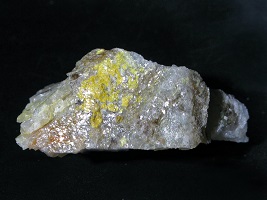
Locality: Parker Mtn. Mine, Strafford, NH
Specimen Size: 4 cm specimen with crust of yellow phosphuranylite - not fluorescent
Field Collected: Gene Bearss
Catalog No.: 2104
Notes: Phosphuranylite identification by similarity to analyzed Parker Mtn. specimen #2050. Bright green fluorescent autunite is also present on this specimen.
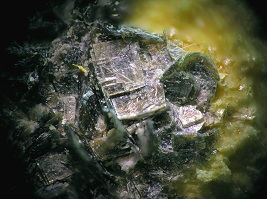
Locality: Rt. 89 Road Cut, New London, NH
Specimen Size: 3 mm field of view.
Field Collected: Bob Whitmore
Catalog No.: u935
Notes: [tm] I had these identified as torbernite for many years The vertical, leak green, somewhat octagonal, crystal is indicative of the true color. The square plates have a lot of reflected light.
In July, 2017, Fred Davis wrote: "I looked at the "torbernite" from I-89 I purchased at MMNE in the micromount box. I did a "bulk" analysis over a 3mm circle covered with the flat, square crystals. No copper - not even a whiff, [tm - required for torbernite]. I think it's also phosphuranylite (got all the right elements)."
A follow-up EDS analysis (BC227) supports Fred's conclusion. Inexplicably, as in the Parker Mtn. phosphuranylite above, the potassium line at 3.3 KeV was not labeled by the element ID software (and fails to show in the element table). I have manually labeled this in blue
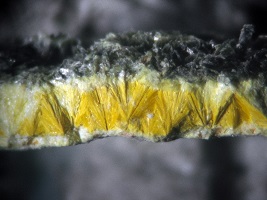
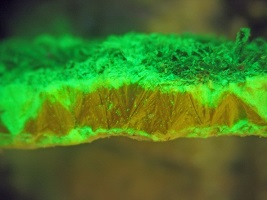
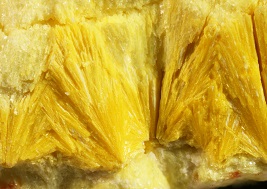
Locality: Rt. 89 roard cut, New London, NH
Specimen Size: 1 cm field of view.
Field Collected: Bob Whitmore - 1980's
Catalog No.: u935
Notes: Two photos of the specimen that provided the EDS analysis grain, one in daylight and one is SWUV. The yellow mineral is not fluorescent (or at best, weakly fluorescent). There is a green autunite fluorescence on the perimeter of the yellow mineral. The top-side of the specimen (this is an edge view) is coated with tiny olive-green crystals originally visually identified as torbernite, but subsequently analyzed to also be phosphuranylite. Bob Whitmore had this yellow bladed mineral labeled as uranophane.
Multiple polished grain EDS analyses (BC123, BC203) showed a Ca, U phosphate. All analyses had a strong response line at about 3.3 KeV, but, inexplicably, in only one EDS analysis was this potassium (K) line identified.
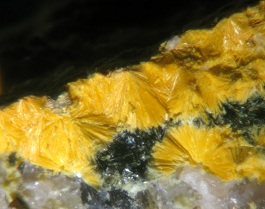
Locality: Rt. 89 Road cut, New London, NH
Specimen Size: 8 mm field of view.
Field Collected: Bob Whitmore
Catalog No.: u934
Notes:
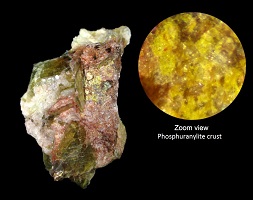
Locality: Ruggles Mine, Grafton, NH
Specimen Size: 2.5 cm specimen. Bright yellow Phosphuranalite crust near center.
Field Collected: Unknown
Catalog No.: u434
Notes: Identification from dealer source
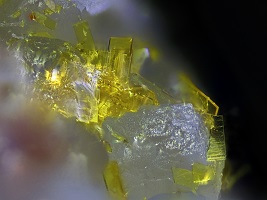
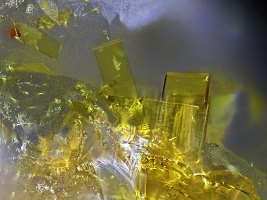
Locality: Ruggles Mine, Grafton, NH
Specimen Size: 1.3 mm field of view and 0.9 mm zoom view
Field Collected: Harvard research
Catalog No.: u2375
Notes: These small crystals have a thin rectangular bladed habit, typical for the species.
Used low temperature LED light source for these photos as I did not want to heat them in any way. Phosphuranylite contains a lot of water.
No, these do not fluoresce.
Differentiating phosphuranylite from uranophane (and uranophane-beta) visually is very risky. All three can present as orthorhombic appearing yellow crystals. EDS can easily resolve this, as phosphuranylite is a phosphate and uranophane (& beta) are silicates. Both uranophane and phosphuranylite are reported from Ruggles. These crystals are in thin seams in fluorapatite, a mineral containing both P and Ca, required for phosphuranylite. Testing planned.
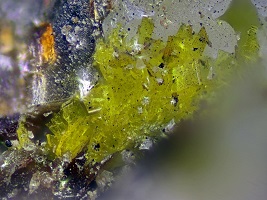
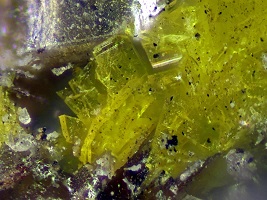
Locality: Ruggles Mine, Grafton, NH
Specimen Size: 1.1 mm field of view and zoom view of lower left area
Field Collected: Harvard research
Catalog No.: u2375
Notes: Lots of "crud" on these crystals, but reluctant to put in ultrasonic.